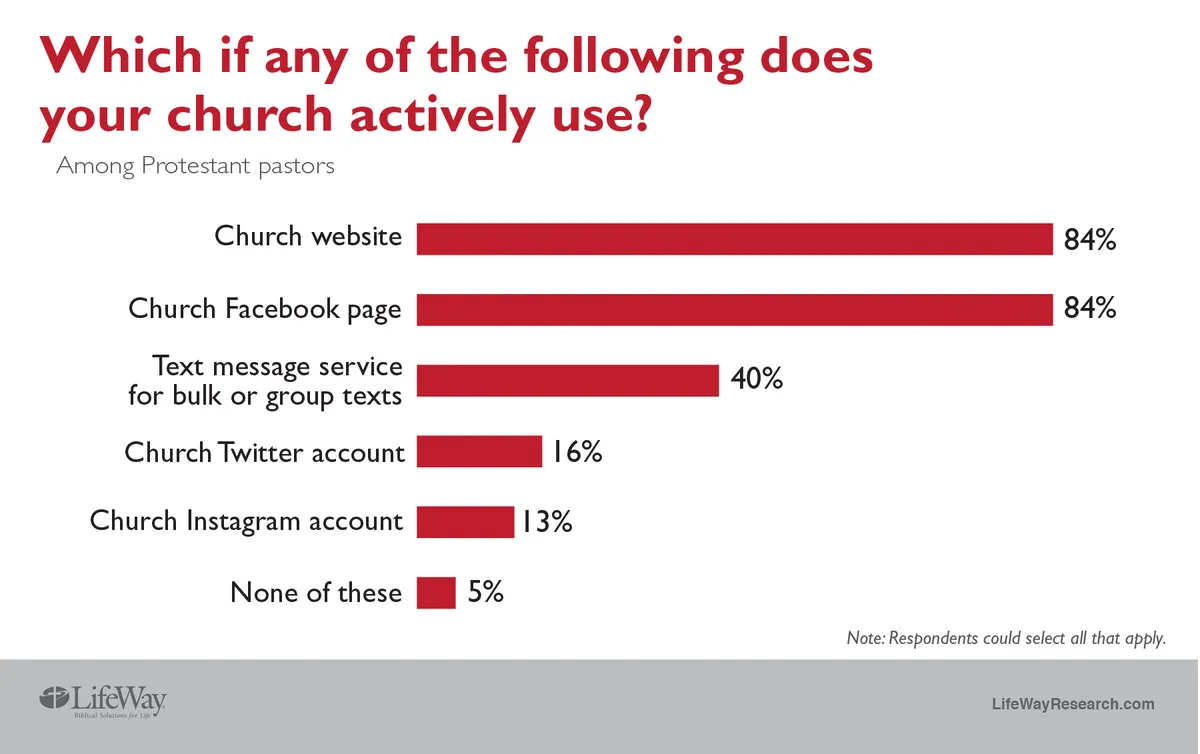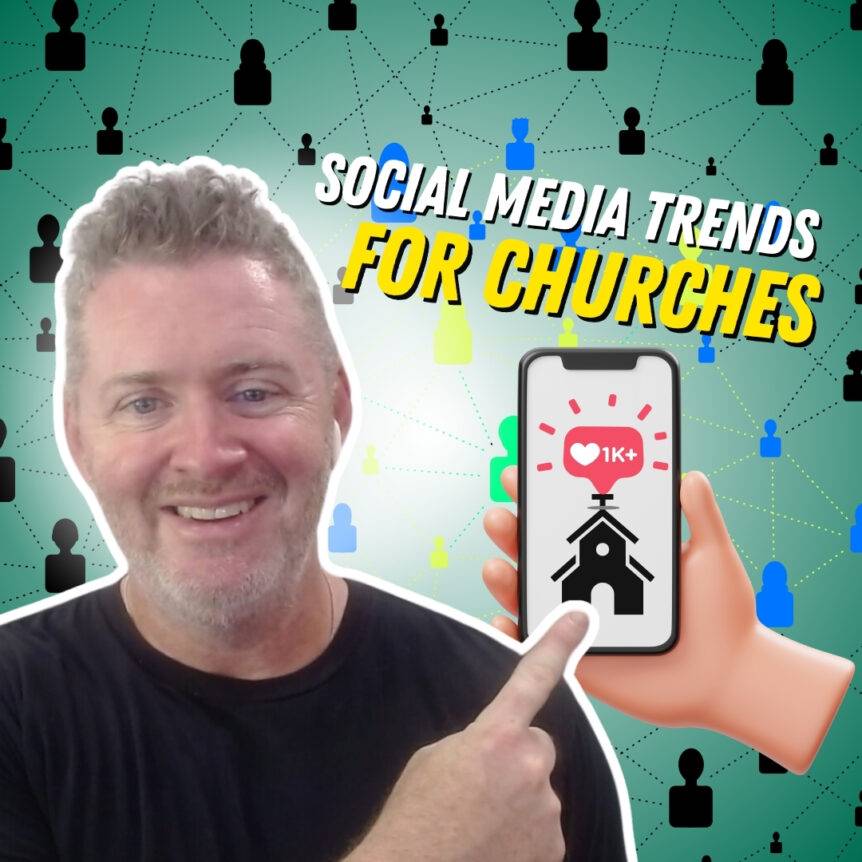In recent years, social media has become a powerful tool for churches to reach and engage their communities. With more people connecting online than ever before, especially after the pandemic, it’s crucial for churches to stay current with digital outreach trends.
In 2024, new trends are emerging that can help churches enhance their online presence and connect more deeply with their congregations. This podcast explores these trends and offers practical tips for church leaders and social media managers. Whether it’s through short videos, live streaming, or engaging content, the goal is to make digital outreach more effective and meaningful.
By understanding and implementing these trends, your church can continue to grow and thrive in an increasingly digital world. Ready to learn more?
Let’s jump in.
Estimated reading time: 10 minutes
Table of contents
Social Media in Churches

Before we jump into the social media trends we think your church should be using, let’s explore more about social media in churches. For many of us, social media is a new thing that maybe we don’t fully understand. However, social media is here to stay, and if we want to leverage the huge advantage it provides, we need to know more about it.
Let’s explore more about social media in churches so we can better use it to our advantage.
Historical Context
Over the past decade, social media has dramatically changed how churches connect with their communities. In the early 2010s, churches began experimenting with social media platforms like Facebook and Twitter. Initially, social media posts were simple, often just announcements or Bible verses. However, as social media grew, so did its role in church life.
Churches quickly realized the potential of these platforms to reach people beyond their immediate congregation. They started sharing more diverse content, including photos from events, inspirational messages, and videos of sermons. This shift helped churches create a more engaging social media presence. Instead of just informing, they began to inspire and connect.
One key milestone was the introduction of live streaming. Churches started broadcasting their services live on social media platforms, allowing members who couldn’t attend in person to still participate. This was especially valuable for those who were sick, elderly, or traveling. It also opened the door for new people to experience church life from the comfort of their homes. “Church online” was a whole new horizon.
As technology advanced, so did the creativity of churches on social media. They began using tools like Instagram Stories and Facebook Live to share behind-the-scenes looks at church activities, engage in real-time Q&A sessions, and host online prayer meetings. These efforts not only kept the congregation informed but also made them feel more connected and involved.
Current Landscape
Today, the use of social media in churches is more important than ever. In 2023, it was reported that a majority of churches had active profiles on various social media platforms like Facebook, Instagram, and YouTube. According to Lifeway Research, 84% of churches nowadays have a Facebook page.

These social media platforms are now essential tools for daily communication and outreach.
A church’s social media presence can significantly influence its growth and community engagement. Effective social media posts can attract new visitors, keep current members informed, and provide spiritual encouragement throughout the week. For example, many churches now post daily devotionals, inspirational quotes, and snippets from sermons to keep their community engaged and inspired.
Social media has also become a space for churches to showcase their community work and events. Sharing photos and videos from mission trips, charity events, and community service projects helps highlight the active role the church plays in local and global communities. This visibility can attract people who are looking to get involved in meaningful activities.
One standout example of successful church social media is Elevation Church, which has a massive online following. They use a variety of content types, from professional-quality videos to heartfelt testimonies, to engage their audience. Their social media posts are not just informative but also deeply personal and relatable, making their social media presence strong and impactful.
Another example is the use of interactive content like polls, quizzes, and live Q&A sessions. These tools encourage active participation and make the church’s social media pages more dynamic and engaging. Churches also utilize hashtags to create a sense of community and make their posts more discoverable.
Church Social Media
Overall, the current landscape shows that churches with a strong social media presence are better able to connect with their congregation and reach out to potential new members.
By continuously adapting to new social media trends and tools, churches can ensure their message remains relevant and accessible in today’s digital world.
Key Social Media Trends for 2024

Now that we know more about social media, let’s dive into 2024 social media trends. These trends are all the things working on social media right now. We can’t say this will be the meta forever, so we encourage you to use these as soon as you can. We hope to provide updates each year as social media strategies shift and change. We want to make sure you always have the best social media strategy on deck.
Trend 1: Short-Form Video Content
In 2024, short-form video content is expected to dominate social media. Platforms like TikTok and Instagram Reels are becoming increasingly popular for their quick and engaging content. Churches can take advantage of this trend by creating short, impactful videos that capture the essence of their message in just a few seconds.
This user-generated content can include highlights from sermons, inspirational messages, or behind-the-scenes glimpses of church events. The church’s social media team can work together to brainstorm creative ideas and produce content that resonates with both current church members and potential newcomers.
Trend 2: Live Streaming and Virtual Services
Live streaming and virtual services continue to be crucial in 2024. Many people still prefer or need to attend church online, whether due to health reasons, distance, or personal preference. Enhancing the live streaming experience can make a big difference in how connected viewers feel.
Using high-quality cameras and sound equipment, along with engaging visuals, can help create a more immersive experience. Additionally, offering interactive features like live chat during services allows church members to connect with each other and with church leaders in real-time. This can make online attendees feel more involved and part of the community.
Trend 3: Authentic and Relatable Content

Authenticity is key, no matter the social media channel. Church members want to see real, relatable content that speaks to their everyday lives. This means sharing more than just polished, professional posts. Churches should consider posting candid photos, heartfelt stories, and honest reflections from both leaders and members.
Content that shows the human side of the church can create a stronger emotional connection. For example, a social media post sharing testimonies, personal struggles, and moments of joy can make the church’s online presence feel more genuine and welcoming. This approach can help attract a younger audience who values transparency and authenticity.
Trend 4: Community Engagement and Interaction
In 2024, social media is not just about broadcasting messages; it’s about building community. Engaging with church members through social media channels is essential. This can be done through interactive posts like polls, Q&A sessions, and discussion prompts. Encouraging your target audience to share their own stories and experiences can also foster a sense of belonging and participation.
For instance, a church might create a hashtag for members to use when posting about church events or personal faith journeys. The church’s social media team can then share these posts, highlighting the diverse and vibrant community within the church. This interactive approach helps to build stronger connections and makes the church online feel more like a real community.
Trend 5: Collaboration and Partnerships
Collaboration and partnerships are becoming more important in church social media strategy. Partnering with other churches, local organizations, or influencers can help expand reach and impact. For example, collaborating on community service projects and then sharing these efforts on social media can highlight the church’s commitment to making a difference.
Partnering with influencers who share the church’s values can also help reach a broader audience. These collaborations can bring new perspectives and ideas, enriching the church’s social media content. By working together, churches can amplify their message and make a greater impact both online and offline.
Implementing These Trends

Those are our top 5 social media trends for 2024! Now that you have an understanding of them, let’s dig deeper into actually implementing these strategies.
Assessing Your Current Social Media Strategy
Start by evaluating your church’s current social media presence. Look at which social media channels you are using and analyze what types of posts get the most engagement. Ask for feedback from church members to understand what they like and what they would like to see more of. This assessment will help you identify strengths and areas for improvement.
Developing a Content Plan
Next, create a content plan that incorporates the key trends. Develop a content calendar that schedules a mix of short-form videos, live streaming events, authentic stories, and interactive posts. Ensure that your content is varied and consistent. Plan ahead for special church events and seasons, making sure you have engaging posts ready to share. This planning will help keep your social media presence active and interesting.
Engaging Your Congregation
Involve your congregation in your social media strategy. Encourage church members to share their own stories, photos, and experiences using a specific hashtag. Feature these posts on your church’s social media channels to showcase the community. Host live Q&A sessions, polls, and interactive discussions to make your social media pages more engaging. The more you involve your congregation, the more connected they will feel.
Measuring Success
Track the performance of your social media efforts using analytics tools. Monitor key metrics such as likes, shares, comments, and overall reach. Pay attention to which types of posts perform best and adjust your strategy accordingly. Regularly reviewing these metrics will help you understand what resonates with your audience and how you can improve. Use this data to make informed decisions and continually refine your social media approach.
By carefully assessing, planning, engaging, and measuring, your church can effectively implement these trends and enhance its social media presence. This will help you connect more deeply with your congregation and reach new people.
Church Social Media Trends

In conclusion, embracing the latest social media trends can significantly enhance your church’s online presence and community engagement. By implementing strategies such as short-form videos, live streaming, authentic content, interactive posts, and partnerships, your church can connect more deeply with current members and attract new ones.
It’s essential to continually assess your efforts, develop a thoughtful content plan, actively engage your congregation, and measure your success. Adapting to these trends not only keeps your church relevant in the digital age but also fosters a stronger, more connected community. As you move forward, remember that the heart of your social media strategy should always be to inspire, inform, and bring people closer together in faith.
With dedication and creativity, your church’s social media presence can thrive and make a meaningful impact. We can’t wait to hear about how it goes in the comments. If you have any other social media trends for 2024, comment those below as well! God bless!
More on Social Media





